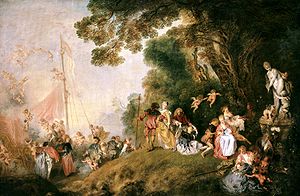This article needs additional citations for verification. Please help improve this articlebyadding citations to reliable sources. Unsourced material may be challenged and removed.
Find sources: "Fête galante" – news · newspapers · books · scholar · JSTOR (March 2013) (Learn how and when to remove this message) |
Fête galante (French pronunciation: [fɛːt ɡalɑ̃t]) (courtship party) is a category of painting specially created by the French Academy in 1717 to describe Antoine Watteau's (1684–1721) variations on the theme of the fête champêtre, which featured figures in ball dress or masquerade costumes disporting themselves amorously in parkland settings. When Watteau applied to join the French academy in 1717, there was no suitable category for his works, so the academy simply created one rather than reject his application. His reception piece was the Embarkation for Cythera, now in the Louvre.[1][2][3]

Watteau wanted recognition from the government-appointed Academy of Painting and Sculpture. The Academy upheld the hierarchy of genres, ranking scenes of everyday life and portraits, the paintings most desired by private patrons, as lower than morally educational paintings illustrating history paintings, including allegories and scenes from mythology.
Fête galante paintings are an important part of the Rococo period of art, which saw the focus of European arts move away from the hierarchical, standardized grandeur of the church and royal court and toward an appreciation for intimacy and personal pleasures. Nonetheless, the lush, outdoor settings of fête galante paintings were often borrowed from earlier paintings, especially from Venetian paintings of the 16th century and Dutch paintings of the 17th century.
The nineteenth century saw an anachronistic revival of such scenes in the costume genre depictions or scene galante paintings by, for example, Arturo Ricci.